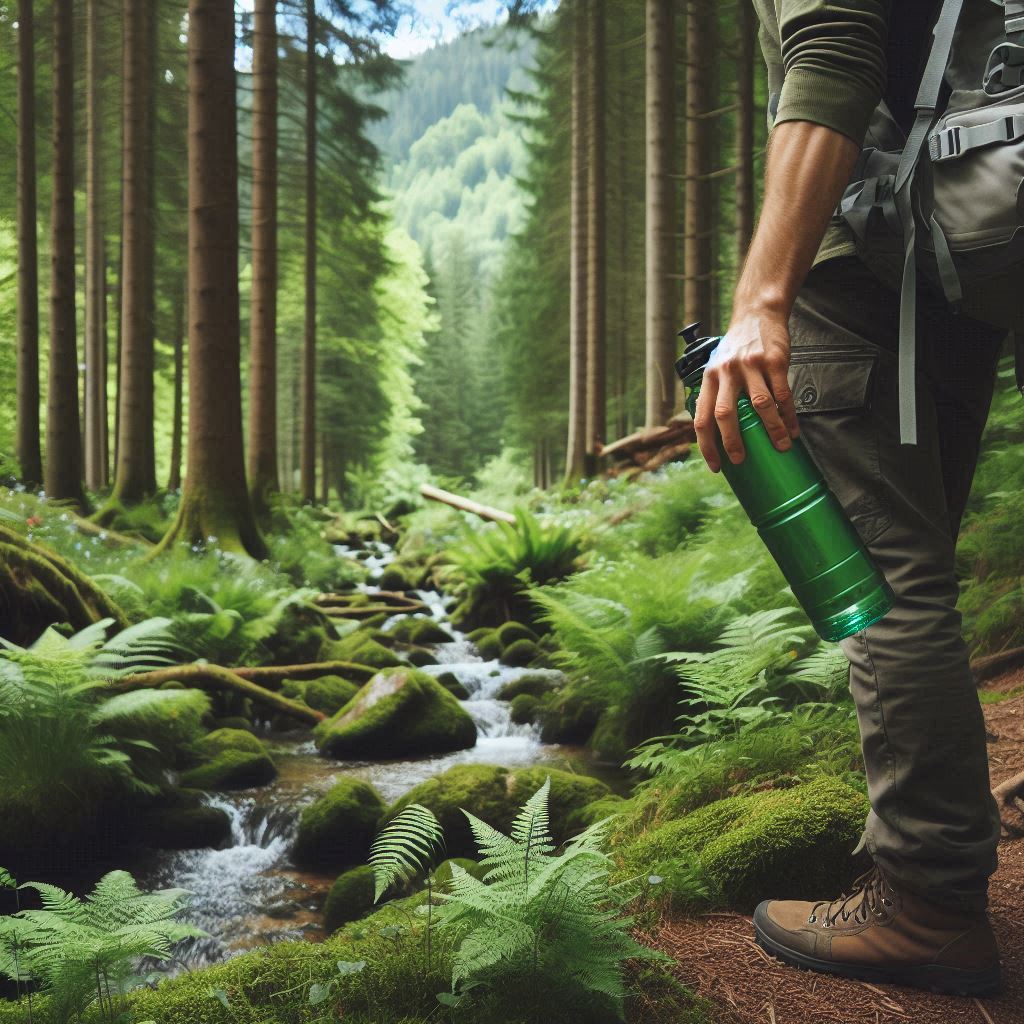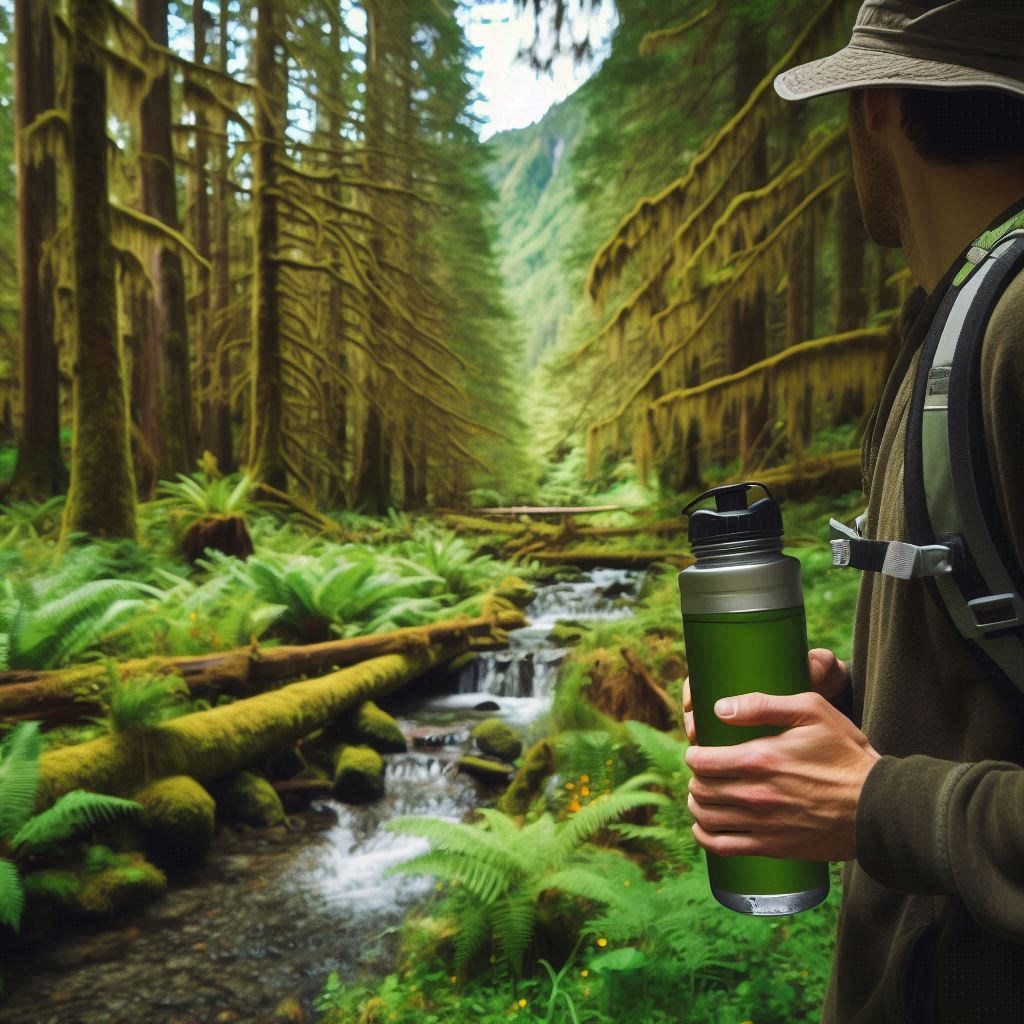Getting lost in a forest can be a daunting experience, but with the right knowledge and actions, you can increase your chances of survival. This article aims to provide a detailed guide on what you need to know and what actions to take to survive if you find yourself lost in a forest.
What You Need to Know:

Basic Survival Skills:
Having basic survival skills is paramount when facing the challenges of being lost in a forest. One of the first priorities is finding shelter to protect yourself from the elements. Familiarize yourself with techniques for building shelters from natural materials such as branches, leaves, and debris. Look for suitable locations such as under thick tree canopies or against natural rock formations. Constructing a shelter not only provides a sense of security but also helps regulate body temperature and conserve energy, especially during inclement weather conditions.
In addition to shelter, acquiring knowledge of identifying edible plants and starting a fire is essential for sustaining yourself in the forest. Learn to recognize common edible plants and berries, as well as poisonous ones to avoid. Understanding the principles of fire starting using various methods such as friction-based techniques, flint and steel, or modern tools like lighters or matches is crucial. Fire provides warmth, protection from wildlife, and the means to cook food, purify water, and signal for help. Mastering these survival skills equips you with the necessary tools to navigate and thrive in the wilderness until rescue arrives.
Navigation:

Mastering basic navigation skills is paramount for increasing your chances of survival when lost in a forest. Equip yourself with the knowledge of using a compass, a fundamental tool for determining direction even when landmarks are not visible. Additionally, familiarize yourself with reading maps, which provide valuable information about terrain features, water sources, and potential escape routes. Practice orienteering techniques such as identifying prominent natural landmarks like mountains, rivers, or distinctive tree formations to help maintain your bearings within the forest.
Incorporating modern technology alongside traditional navigation methods can further enhance your ability to find your way out of the forest. Utilize GPS devices or navigation apps on your smartphone, if available, to pinpoint your location and plot a course to safety. However, always have a backup plan in case electronic devices fail or lose battery power. By honing your navigation skills and combining them with technological aids, you can confidently navigate the dense vegetation and intricate pathways of the forest, increasing your chances of finding your way back to civilization.
Local Wildlife:

Maintaining awareness of the diverse wildlife inhabiting the forest is crucial for your safety. Be mindful of potential encounters with wild animals and take proactive measures to avoid dangerous situations. Educate yourself on how to identify common wildlife species and understand their behavior, such as recognizing signs of aggression or territoriality. Additionally, learn to distinguish between harmless and venomous creatures, as well as poisonous plants, to minimize the risk of accidental exposure. By staying vigilant and respecting the natural inhabitants of the forest, you can reduce the likelihood of dangerous encounters and navigate the wilderness more safely.
In the event of an encounter with wildlife, it’s essential to remain calm and avoid provoking or startling the animals. Give them space and slowly back away without making sudden movements or loud noises. If confronted by a potentially dangerous animal, know how to respond appropriately based on its species and behavior. For example, with large mammals like bears or cougars, stand tall, make yourself appear larger, and slowly retreat while avoiding direct eye contact. With venomous snakes or insects, give them a wide berth and move cautiously around them. By understanding wildlife behavior and taking proactive measures to avoid confrontations, you can minimize risks and enjoy a safer experience in the forest.
Water Sources:

In a forest environment, access to clean water is paramount for sustaining life. Understanding how to locate water sources such as streams, rivers, or natural springs is crucial, as these are often the most reliable sources of freshwater. Look for signs such as lush vegetation or animal tracks that may indicate the presence of water nearby. Once you’ve found a water source, it’s imperative to purify it before consumption to avoid waterborne illnesses. Employ various purification methods such as boiling the water over a fire, using portable water filtration devices, or adding purification tablets to kill harmful bacteria and parasites. These techniques ensure that the water you drink is safe and potable, reducing the risk of dehydration and illness while lost in the forest.
Additionally, it’s essential to understand the principles of water conservation in a survival situation. Conserve precious water resources by rationing your intake and using alternative methods for hygiene purposes. Collect rainwater using improvised containers such as tarps or large leaves, and consider digging a shallow well near the water source to access groundwater. By combining effective water location strategies with purification techniques and conservation practices, you can maintain hydration and increase your chances of survival while navigating the challenges of being lost in the forest.
Shelter Building:

Constructing a shelter is vital for surviving in the forest, as it provides protection from the elements and helps regulate body temperature. Familiarize yourself with various types of shelters that can be built using natural materials found in the forest, such as branches, leaves, and debris. Consider options like lean-to shelters, A-frame shelters, or debris huts, depending on the available materials and prevailing weather conditions. Choose a suitable location for your shelter, preferably on elevated ground away from potential hazards like falling branches or flooding areas.
When building a shelter, pay attention to factors such as insulation, ventilation, and stability. Use sturdy branches or logs as the framework and layer them with leaves, pine needles, or other foliage to create a waterproof covering. Ensure the shelter is well-ventilated to prevent condensation buildup and allow airflow. Additionally, reinforce the structure to withstand strong winds or inclement weather by securing branches firmly in place and adding extra support if needed. By mastering the art of shelter construction, you can create a safe and comfortable refuge in the forest, increasing your chances of survival until help arrives.
First Aid:

Having basic knowledge of first aid is essential for dealing with injuries and illnesses that may occur while lost in the forest. Familiarize yourself with fundamental first aid techniques such as treating cuts, burns, sprains, and insect bites. Carry a well-equipped first aid kit containing essential supplies like bandages, antiseptic wipes, pain relievers, and adhesive tape to address common medical issues promptly.
In addition to basic first aid skills, it’s essential to understand how to assess the severity of injuries and prioritize treatment accordingly. Learn to recognize signs of more serious conditions such as hypothermia, heatstroke, or allergic reactions, and know when to seek professional medical assistance if necessary. By being prepared to handle medical emergencies effectively, you can mitigate risks and ensure your well-being while navigating the challenges of being lost in the forest.
Edible Plants:

Familiarizing yourself with edible plants in the area is crucial for supplementing your food supply while lost in the forest. Take the time to research and identify common edible plants native to the region, such as wild berries, nuts, and leafy greens. Learn to distinguish between edible and poisonous plants by studying their characteristics, such as leaf shape, color, and growth pattern. Carry a field guide or reference material with illustrations to aid in plant identification and verification.
In addition to identifying edible plants, it’s essential to understand proper harvesting and preparation techniques to ensure their safety for consumption. Harvest plants from areas free of pesticides, pollution, or contamination, and wash them thoroughly before eating. Start by sampling small amounts of new plants to test for any adverse reactions or allergies. When in doubt, consult with local experts or experienced foragers to verify the edibility of plants and minimize the risk of ingesting harmful substances. By expanding your knowledge of edible plants and practicing caution during foraging, you can supplement your diet with nutritious food sources and enhance your chances of survival in the forest.
Fire Starting:

Fire serves as a vital tool for survival in the forest, providing warmth to combat cold temperatures, a means to cook food, and a visible signal for attracting attention in case of rescue. It is essential to practice various fire-starting techniques to ensure reliability in any situation. Familiarize yourself with using basic tools such as lighters and matches, which offer convenience and simplicity in igniting fires. Additionally, hone your skills in more primitive methods like the bow drill or fire plow, which rely on friction to generate heat and ignite tinder. Regular practice will help you develop proficiency in fire starting, even under challenging conditions such as damp weather or limited resources.
When starting a fire in the forest, it’s crucial to prioritize safety and environmental responsibility. Select a suitable location away from dry vegetation, overhanging branches, or other potential fire hazards. Clear the area of debris and create a fire ring or pit to contain the flames. Gather a sufficient supply of dry tinder, kindling, and fuelwood to sustain the fire, and gradually build it up to a manageable size. Monitor the fire closely and extinguish it completely before leaving to prevent the risk of wildfires. By mastering fire-starting techniques and practicing responsible fire management, you can harness this essential resource for survival while minimizing environmental impact.
Weather Patterns:

Understanding local weather patterns is essential for preparing and adapting to the ever-changing conditions in the forest. By familiarizing yourself with typical weather trends, such as temperature fluctuations, precipitation, and storms, you can better anticipate and plan for potential challenges. Pay close attention to cues from nature, such as cloud formations, wind direction, and changes in air pressure, which can provide valuable insights into impending weather changes. Additionally, utilize weather forecasting tools or apps to stay updated on current conditions and any upcoming weather alerts or advisories.
Incorporate weather awareness into your daily routine while navigating the forest. Take note of the sky’s appearance throughout the day, observing shifts in cloud cover, color, and movement. Monitor changes in wind direction and intensity, as they can indicate approaching weather systems. Be prepared to adjust your plans and activities accordingly in response to changing weather conditions, such as seeking shelter or altering your route to avoid potential hazards. By staying vigilant and informed about local weather patterns, you can enhance your safety and resilience while exploring the wilderness.
Signaling:

Having knowledge of how to signal for help is crucial for increasing your chances of being rescued when lost in the forest. Practice using various signaling methods such as creating smoke signals from a fire, flashing mirrors or reflective materials to catch the attention of passing aircraft or search parties, and using audible signals such as whistles or shouts to alert nearby rescuers. Choose high ground or open areas to maximize the visibility of your signals and increase the likelihood of being spotted by potential rescuers.
In addition to traditional signaling techniques, consider utilizing modern technology such as personal locator beacons (PLBs) or satellite communication devices if available. These devices can transmit distress signals and your precise location to emergency responders, greatly expediting the rescue process. However, always have backup signaling methods in case electronic devices fail or lose battery power. By mastering a variety of signaling techniques and being prepared with the necessary equipment, you can effectively communicate your distress and improve your chances of being found and rescued in the forest.
Psychological Preparedness:

Mental preparedness is just as crucial as physical skills when facing the stress and challenges of being lost in the wilderness. Cultivate a resilient mindset by acknowledging and accepting the situation, rather than succumbing to panic or despair. Stay focused on the present moment and prioritize tasks that contribute to your survival, such as finding shelter, water, and signaling for help. Remind yourself that maintaining a positive attitude and staying determined are key factors in overcoming adversity and increasing your chances of being rescued.
Practice mindfulness and relaxation techniques to manage stress and anxiety during uncertain times. Take deep breaths, engage in grounding exercises, and visualize positive outcomes to maintain a sense of calm and clarity. Stay connected with your inner strength and resilience, drawing upon past experiences of overcoming challenges to boost your confidence and motivation. Additionally, seek support from fellow survivors if you’re in a group, providing encouragement and solidarity in navigating the wilderness together. By fostering mental preparedness and resilience, you can navigate the trials of being lost in the wilderness with greater confidence and determination.
Actions to Take:
Stay Calm:

Panicking in a wilderness survival situation can exacerbate the challenges you face, as it clouds your judgment and impairs your ability to think clearly. Instead of succumbing to panic, consciously take deep breaths and focus on maintaining a calm demeanor. By staying composed, you can approach your predicament with a rational mindset, enabling you to assess your situation more effectively and make sound decisions based on available resources and circumstances.
In moments of uncertainty, it’s essential to remind yourself to stay grounded and avoid reacting impulsively. Take deliberate actions to address immediate needs, such as finding shelter, water, or signaling for help, while remaining mindful of your surroundings and potential hazards. By maintaining a sense of calm and composure, you can navigate the challenges of being lost in the wilderness with greater clarity and resilience, ultimately increasing your chances of survival until help arrives.
Stay Put:

In the wilderness, staying in one place can significantly increase your chances of being located by search and rescue teams. Moving around aimlessly can make it difficult for rescuers to track your movements and may lead you further away from potential help. Instead, establish a base camp or shelter in a visible and easily accessible location, such as an open clearing or near a prominent landmark.
Once you’ve established your position, focus on maximizing your visibility to potential rescuers. Create signals using brightly colored clothing, reflective materials, or smoke from a fire to attract attention from passing aircraft or search parties on the ground. By remaining stationary and making yourself easily detectable, you enhance the likelihood of being located swiftly and safely, ultimately expediting your rescue from the wilderness.
Find Shelter:

In the wilderness, shelter is paramount for protecting yourself from the elements and maintaining body temperature. If you’re unable to find a pre-existing shelter, such as a cave or overhang, consider constructing a temporary shelter using natural materials. Look for sturdy branches, leaves, and foliage to create a basic structure that provides protection from rain, wind, and cold temperatures. Utilize nearby trees or rock formations as anchor points for your shelter, ensuring stability and security.
When building your shelter, prioritize insulation and weatherproofing to enhance comfort and survivability. Layer branches and foliage to create a thick barrier against wind and rain, and use additional materials such as pine boughs or moss for added insulation. Ensure your shelter is large enough to accommodate your body and any essential belongings, while also allowing for adequate ventilation to prevent condensation and moisture buildup. By seeking or constructing a shelter, you can mitigate the harsh effects of the wilderness environment and increase your chances of surviving until help arrives.
Signal for Help:

In a wilderness survival scenario, signaling for help is essential for increasing your chances of being located by rescuers. Utilize signaling devices such as whistles, mirrors, or brightly colored clothing to attract attention from passing aircraft or search parties. These items can serve as visible and audible cues that indicate your presence, especially in dense forested areas where visibility may be limited. Additionally, consider creating signals on the ground using rocks or branches arranged in conspicuous patterns, such as SOS or X marks, to further enhance your visibility from the air or ground.
When creating ground signals, prioritize visibility and simplicity to ensure they can be easily recognized from a distance. Arrange rocks or branches in large, contrasting patterns against the natural surroundings to maximize visibility and catch the attention of potential rescuers. Place signals in open areas or on elevated ground where they are more likely to be spotted from aircraft or search teams on the ground. By employing a combination of signaling devices and ground signals, you can effectively communicate your distress and expedite your rescue from the wilderness.
Stay Hydrated:

Staying hydrated is paramount for survival in the wilderness, especially in environments where water sources may be scarce or unreliable. Make a conscious effort to drink water regularly throughout the day to prevent dehydration and maintain optimal bodily functions. If you find yourself running low on water supplies, prioritize conservation by rationing your intake and avoiding activities that lead to excessive sweating, such as strenuous exertion or prolonged exposure to direct sunlight. By conserving water and being mindful of your hydration levels, you can prolong your survival in the wilderness and preserve your physical well-being.
Additionally, consider alternative methods for obtaining water in the wilderness to supplement your existing supplies. Look for natural sources such as streams, rivers, or lakes, and utilize purification techniques to make the water safe for consumption. Collect rainwater using improvised containers such as tarps or large leaves, and utilize moisture from plants or morning dew as additional sources of hydration. By diversifying your water procurement strategies and implementing conservation measures, you can effectively manage your hydration needs and increase your chances of survival while navigating the challenges of the wilderness.
Gather Food:

When foraging for food in the wilderness, familiarize yourself with common edible plants, berries, nuts, and insects that are safe for consumption. Take the time to research and identify these resources beforehand, paying close attention to distinguishing features and potential look-alikes that may be poisonous. Look for signs of ripeness or maturity in fruits and berries, and gather them from areas free of contamination or pollution. Additionally, consider insects as a valuable source of protein and energy, and learn to identify edible varieties such as grasshoppers, crickets, and larvae. However, exercise caution and avoid insects with bright colors or strong odors, as they may indicate toxicity.
While it’s essential to utilize available resources for sustenance in the wilderness, exercise caution when consuming unknown plants or mushrooms. Avoid ingesting any vegetation unless you are absolutely certain of its safety and edibility. When in doubt, consult reliable field guides or seek guidance from experienced foragers or survival experts to verify the edibility of unfamiliar species. Remember that some plants and mushrooms may be toxic or poisonous, and even small quantities can cause severe illness or death. By adhering to the principle of “when in doubt, do not eat,” you can minimize the risk of accidental poisoning and ensure your safety while foraging for food in the wilderness.
Stay Warm:

Building a fire is essential for survival in the wilderness, providing warmth and protection against hypothermia, especially in cold or damp conditions. Begin by gathering dry wood, tinder, and kindling from the surrounding environment, selecting materials that are readily combustible and free from moisture. Arrange the firewood in a teepee or log cabin structure, leaving enough space for air circulation to facilitate combustion. Use a reliable fire-starting method such as matches, lighters, or a fire striker to ignite the tinder, gradually adding larger pieces of fuelwood to sustain the flames. Maintain the fire by periodically feeding it with additional fuel as needed, ensuring a steady heat source to keep warm and ward off the risk of hypothermia.
While building and maintaining a fire, prioritize safety and environmental responsibility to minimize the risk of accidents or wildfires. Choose a suitable location for your fire pit, preferably on bare soil or rocks, away from dry vegetation, overhanging branches, or other potential fire hazards. Keep a bucket of water or sand nearby to extinguish the fire completely when not in use, and never leave a fire unattended. Additionally, adhere to Leave No Trace principles by avoiding excessive wood consumption and ensuring that the fire pit is thoroughly extinguished and cool to the touch before departing. By responsibly building and tending to your fire, you can harness its warmth and light for survival while minimizing its impact on the surrounding wilderness.
Stay Visible:

Increasing your visibility to search teams is crucial for expediting your rescue from the wilderness. Utilize signaling devices such as brightly colored clothing, reflective materials, or signal mirrors to create visible cues that can be spotted from a distance. Position yourself in open areas or on elevated ground where you are more likely to be seen by passing aircraft or ground search teams. Additionally, consider creating ground signals using rocks, branches, or other natural materials arranged in conspicuous patterns such as SOS or X marks to further enhance your visibility and communicate your distress.
In the event that you hear or see aircraft or rescue teams in the vicinity, take proactive measures to attract their attention. Make noise by shouting, blowing a whistle, or banging on objects to create audible signals that can alert rescuers to your location. Wave your arms, clothing, or any available signaling devices to draw attention to your position and indicate that you require assistance. By actively participating in the search and rescue process and maximizing your visibility, you can significantly increase your chances of being located and safely extracted from the wilderness.
Listen for Sounds:

In a wilderness survival situation, paying attention to sounds of civilization can provide valuable cues that guide you toward potential sources of help. Listen for familiar sounds such as traffic noise, voices, or barking dogs, which may indicate the presence of nearby roads, inhabited areas, or search parties. If you hear these sounds, consider moving towards them if possible, as they may lead you closer to civilization and potential assistance. However, exercise caution and remain vigilant of your surroundings, as navigating unfamiliar terrain may present its own set of challenges and hazards.
While following sounds of civilization, prioritize safety and maintain situational awareness to avoid potential risks or obstacles along the way. Keep an eye out for natural landmarks or signs of human activity that can help orient you and guide your movements towards the source of the sounds. Stay alert for changes in terrain, such as steep slopes, water bodies, or dense vegetation, that may impede your progress or lead you off course. By balancing your desire to reach civilization with prudent decision-making and awareness of your surroundings, you can increase your chances of safely navigating towards potential sources of help in the wilderness.
Stay Positive:

Maintaining a positive attitude is paramount for resilience and mental well-being while facing the challenges of wilderness survival. A positive mindset can boost morale, providing the motivation and determination needed to persevere through difficult circumstances. Embrace each challenge as an opportunity for growth and learning, reframing setbacks as temporary obstacles rather than insurmountable barriers. By cultivating optimism and resilience, you can maintain a sense of hope and determination, enabling you to tackle survival tasks with greater focus and efficiency.
Believe in your ability to overcome obstacles and adapt to changing circumstances in the wilderness. Trust in your skills, knowledge, and resourcefulness to navigate challenges and find solutions to problems as they arise. By approaching each situation with confidence and a can-do attitude, you can harness your inner strength and resilience to overcome adversity and increase your chances of survival. Remember that a positive attitude is a powerful tool that can help you persevere through even the most daunting of wilderness survival scenarios.
Conclusion:
Surviving in a forest when lost demands a comprehensive approach that integrates both practical skills and mental resilience. While acquiring knowledge of survival techniques is essential, maintaining a calm and positive mindset is equally crucial for navigating the challenges of the wilderness. By staying focused on the task at hand, utilizing available resources creatively, and adapting to the ever-changing environment, you can enhance your chances of survival and eventual rescue. Moreover, fostering a sense of hope and optimism can provide the mental fortitude needed to persevere through adversity and uncertainty.
In conclusion, while being lost in the forest can be a daunting experience, it’s important to remember that survival is achievable with the right mindset and approach. By prioritizing safety, conserving resources, and remaining vigilant for potential signs of rescue, you can effectively navigate the wilderness and increase your likelihood of being found and returning safely. Above all, maintain faith in your abilities and trust that help will arrive, even in the most challenging of circumstances. With determination, resilience, and a positive outlook, you can overcome the trials of being lost in the forest and emerge from the experience stronger and more prepared for future adventures.
FAQs (Frequently Asked Questions)
Q1: What should I do if I get lost in the forest?
A1: If you find yourself lost in the forest, the first step is to stay calm and assess your surroundings. Try to remember the route you took and backtrack if possible. If you can’t find your way back, stay in one place to avoid getting more disoriented and make yourself visible to potential rescuers.
Q2: How can I find water in the forest?
A2: Look for signs of water such as vegetation, animal tracks, or low-lying areas. Streams, rivers, and natural springs are common sources of water in forests. Consider using purification methods such as boiling, filtration, or chemical tablets to make water safe for drinking.
Q3: What should I do if I encounter wildlife?
A3: If you encounter wildlife, remain calm and avoid sudden movements. Back away slowly and give the animal space to retreat. If the animal approaches you, make yourself appear larger by raising your arms and making noise to scare it away.
Q4: How can I build a shelter in the forest?
A4: You can build a shelter in the forest using natural materials such as branches, leaves, and debris. Look for sturdy trees or rock formations to serve as a base, and construct a shelter using techniques like lean-tos, A-frames, or debris huts.
Q5: What should I do if I can’t start a fire?
A5: If you’re unable to start a fire, focus on other survival priorities such as finding shelter, water, and signaling for help. Consider alternative methods for staying warm, such as using clothing layers or constructing insulated shelters.
Q6: How can I signal for help in the forest?
A6: You can signal for help in the forest by creating visible signals such as smoke from a fire, reflective materials, or ground signs like SOS or X marks. Additionally, make noise by shouting, blowing a whistle, or banging on objects to attract attention.
Q7: What should I do if I run out of food in the forest?
A7: If you run out of food in the forest, focus on foraging for edible plants, berries, nuts, and insects as sources of sustenance. Be cautious when identifying unfamiliar plants and mushrooms, and prioritize safety to avoid accidental poisoning.
Q8: How can I navigate in the forest without a compass?
A8: You can navigate in the forest without a compass by using natural landmarks, the sun’s position, and your surroundings as reference points. Pay attention to the direction of shadows, prevailing winds, and the movement of celestial bodies to orient yourself.
Q9: What should I do if I encounter inclement weather in the forest?
A9: If you encounter inclement weather such as rain, snow, or storms, seek shelter immediately to stay dry and protect yourself from exposure. Use waterproof clothing and gear to stay warm, and prioritize fire building to provide heat and light.
Q10: How long can I survive without rescue in the forest?
A10: The length of time you can survive in the forest without rescue depends on various factors such as access to water, food, shelter, and your physical condition. Prioritize survival tasks, stay positive, and conserve your resources while waiting for rescue.







